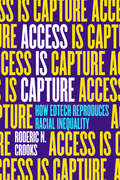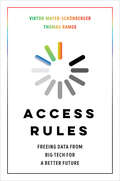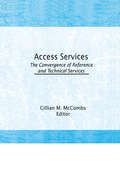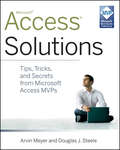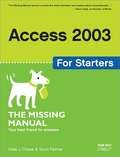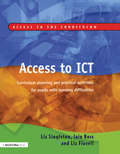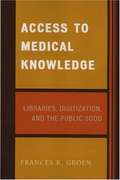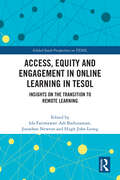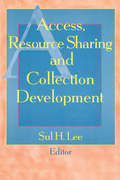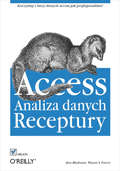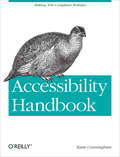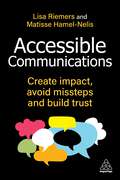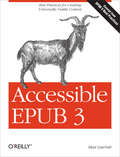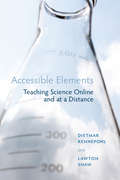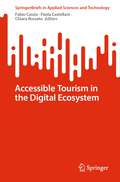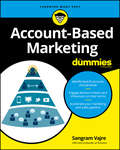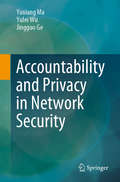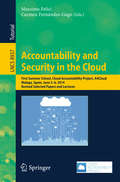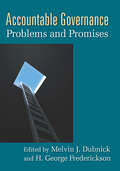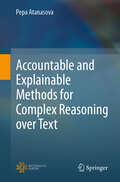- Table View
- List View
Access Is Capture: How Edtech Reproduces Racial Inequality
by Roderic N CrooksRacially and economically segregated schools across the United States have hosted many interventions from commercial digital education technology (edtech) companies who promise their products will rectify the failures of public education. Edtech's benefits are not only trumpeted by industry promoters and evangelists but also vigorously pursued by experts, educators, students, and teachers. Why, then, has edtech yet to make good on its promises? In Access Is Capture, Roderic N. Crooks investigates how edtech functions in Los Angeles public schools that exclusively serve Latinx and Black communities. These so-called urban schools are sites of intense, ongoing technological transformation, where the tantalizing possibilities of access to computing meet the realities of structural inequality. Crooks shows how data-intensive edtech delivers value to privileged individuals and commercial organizations but never to the communities that hope to share in the benefits. He persuasively argues that data-drivenness ultimately enjoins the public to participate in a racial project marked by the extraction of capital from minoritized communities to enrich the tech sector.
Access Rules: Freeing Data from Big Tech for a Better Future
by Viktor Mayer-Schönberger Thomas RamgeA powerful and urgent call to action: to improve our lives and our societies, we must demand open access to data for all. Information is power, and the time is now for digital liberation. Access Rules mounts a strong and hopeful argument for how informational tools at present in the hands of a few could instead become empowering machines for everyone. By forcing data-hoarding companies to open access to their data, we can reinvigorate both our economy and our society. Authors Viktor Mayer-Schönberger and Thomas Ramge contend that if we disrupt monopoly power and create a level playing field, digital innovations can emerge to benefit us all. Over the past twenty years, Big Tech has managed to centralize the most relevant data on their servers, as data has become the most important raw material for innovation. However, dominant oligopolists like Facebook, Amazon, and Google, in contrast with their reputation as digital pioneers, are actually slowing down innovation and progress by withholding data for the benefit of their shareholders––at the expense of customers, the economy, and society. As Access Rules compellingly argues, ultimately it is up to us to force information giants, wherever they are located, to open their treasure troves of data to others. In order for us to limit global warming, contain a virus like COVID-19, or successfully fight poverty, everyone—including citizens and scientists, start-ups and established companies, as well as the public sector and NGOs—must have access to data. When everyone has access to the informational riches of the data age, the nature of digital power will change. Information technology will find its way back to its original purpose: empowering all of us to use information so we can thrive as individuals and as societies.
Access Services: The Convergence of Reference and Technical Services
by Gillian M. McCombsThis book takes a close look at the recent changing emphasis from collections to access, and from document description to document delivery. As the automation of library processes has moved from technical services to reference services, the roles of the professionals working in those capacities have changed dramatically. Library administrators who are looking to redeploy resources will gain helpful insights from the experiences of librarians who have already redirected their organizations. This helpful volume will be of tremendous assistance in redefining the traditional roles of reference and technical librarians. Access Services offers new insights into the movement from bibliographic access to information access that is reshaping reference services today. Informative discussions on topics such as cross-training experiments, revised organizational structures, the new role of the bibliographic utilities, library school education for the redefined professional, and changes in cataloging codes reveal what impact this trend has for librarians, services, and patrons.
Access Solutions
by Douglas J. Steele Arvin MeyerTwo Microsoft Access MVPs show how you can become an Access power user Microsoft Access is the world's leading database system, with millions of users and hundreds of thousands of developers. The best practices, tips, and techniques in this book can turn users into power users. Millions of eager users make Access the most popular database system in the world These Microsoft MVPs exploit key features in Access, providing advice on techniques for capturing, sharing and reporting Access data.Each tip provides detailed solutions with clear instructions for implementation, and samples of all can be found on the companion Web site Access 2010 Solutions offers professional advice that enables every Access user to get greater value from the Access database system.
Access for Starters: The Missing Manual
by Kate J Chase Scott PalmerMaybe you got Access as part of Microsoft Office and wonder what it can do for you and your household; maybe you're a small business manager and don't have a techie on staff to train the office in Microsoft Access. Regardless, you want to quickly get your feet wet--but not get in over your head--and Access 2003 for Starters: The Missing Manual is the book to make it happen. Far more than a skimpy introduction but much less daunting than a weighty tech book, Access 2003 for Starters: The Missing Manual demystifies databases and explains how to design and create them with ease. It delivers everything you need--and nothing you don't--to use Access right away. It's your expert guide to the Access features that are most vital and most useful, and it's your trusted advisor on the more in-depth features that are best saved for developers and programmers. Access is sophisticated and powerful enough for professional developers but easy and practical enough for everyday users like you. This Missing Manual explains all the major features of Access 2003, including designing and creating databases, organizing and filtering information, and generating effective forms and reports. Bestselling authors, database designers, and programmers Scott Palmer, Ph.D., and Kate Chase are your guides for putting the world's most popular desktop data management program to work. Their clear explanations, step-by-step instructions, plenty of illustrations, and timesaving advice help you get up to speed quickly and painlessly. Whether you're just starting out or you know you've been avoiding aspects of the program and missing out on much of what it can do, this friendly, witty book will gently immerse you in Microsoft Access. Keep it handy, as you'll undoubtedly refer to it again and again.
Access to ICT: Curriculum Planning and Practical Activities for Pupils with Learning Difficulties
by Iain Ross Liz Singleton Liz FlavellFirst Published in 2005. Routledge is an imprint of Taylor & Francis, an informa company.
Access to Information: Materials, Technologies, and Services for Print Impaired readers
by Tom Mcnulty Dawn SuvinoThis is a book about alternative media for people with print disabilities
Access to Medical Knowledge: Libraries, Digitization, and the Public Good
by Frances K. GroenGroen examines medical librarianship, tracing its history, and considering changes in the field caused by developments in information technology and telecommunications.<P> She attempts to understand why librarians make certain choices and develop certain services. She draws on her own experiences as a medical librarian and in associations and defines three core values of medical librarians: providing access to the medical literature, empowering and educating library users, and preserving the wisdom of the past. Discussion revolves around access to clinical information and consumer health information in the internet age, challenges to providing access, alternative methods, and communication. The book is meant for medical librarians, professors, and other library and information professionals.<P> Groen has been affiliated with Falk Library of the Health Professions, U. of Pittsburgh, and the medical library at McGill U. in Canada. Annotation ©2007 Book News, Inc., Portland, OR (booknews.com)
Access, Equity and Engagement in Online Learning in TESOL: Insights on the Transition to Remote Learning (Global South Perspectives on TESOL)
by Jonathan Newton Adi Badiozaman, Ida Fatimawati Hugh John LeongThis volume explores difficulties facing TESOL education’s transition to online learning in the Global South and Southeast Asia/Asia Pacific region, highlighting innovations of educators in engaging learners, thereby exploring the key themes of access, engagement, and equity in the field.Discussing themes such as academic burnout, cultural competence, and emotional regulation strategies in challenging educational contexts, this novel volume gives voice to field experiences encountered in countries such as Malaysia, Indonesia, Oman, Vietnam, China, and Iran. Chapters demonstrate how a lack of access to reliable internet connectivity and a shortage of digital devices, especially in rural areas, compound limited opportunities for students already facing educational inequalities, presenting the innovative and creative ways English educators are responding to these situations. Across interviews and qualitative studies, the book demonstrates that issues surrounding engagement with, access to, and equity within, the remote and online educational context are wider and longer lasting than the recent pandemic period itself and are at the forefront of challenges facing these regions today.Highlighting English educators’ resilience, perseverance, and creativity in challenging circumstances, the book will be of interest to researchers, scholars, and postgraduate students in open and distance education, eLearning, bilingualism/ESL, and distribution of technology in educational settings.
Access, Resource Sharing and Collection Development
by Sul H LeeAccess, Resource Sharing, and Collection Development explores the role of libraries in acquiring, storing, and disseminating information in different formats to help you better use technology to share scarce resources and connect library users with collections. With an expressed goal of encouraging continued debate and further investigation, this book provides you with developing strategies and procedures to meet the challenges you face as a collection development librarian during this dynamic time. Among the vital concerns addressed are the competition for limited resources, trends in document delivery, the evaluation of document delivery products, and libraries’options for the future.The chapters collected in Access, Resource Sharing, and Collection Development represent the proceedings of the annual conference held by the University of Oklahoma Libraries and the University of Oklahoma Foundation. The book provides insight into your peers’findings and ideas on: access vs. ownership the future role of the bibliographer changes in collection management managing restrained resource budgets an emphasis on the library user as customer the growth and acceptance of document delivery as a component of collection development and ILL electronic publishing and copyright issues commercial document delivery services Access, Resource Sharing, and Collection Development also shows you how to discover and evaluate "free" resources on the Internet, as standards for production, promotion, and maintenance are nonexistent. The challenge of using these materials is being met by developing criteria for selection, looking at cataloging options, and working in cooperation with other institutions. You’ll also learn the different options for document delivery and how to evaluate document delivery products. Among the book’s advice: you should consider the types of document delivery available, examine the benefits of combining outside services with in-house systems, review the criteria for selecting technologies and suppliers, and explore examples of institutions creating customized systems.
Access. Analiza danych. Receptury
by Ken Bluttman Wayne S. FreezeKorzystaj z bazy danych Access jak profesjonalista!Jak stosowa? wska?niki statystyczne do analizy danych biznesowych?Jak rozszerza? funkcjonalno?? zapyta? SQL, stosuj?c skrypty VBA? Jak przetwarza? dane i przenosi? je mi?dzy bazami Access?Access to znane ju? narz?dzie s?u??ce do wszechstronnego przetwarzania i analizy danych. Posiada sporo ukrytych mechanizmów, pozwalaj?cych efektywnie wykonywa? zadania, które pocz?tkowo mog? wydawa? si? skomplikowane. Ksi??ka przedstawia przyk?ady kwerend, metody przenoszenia danych pomi?dzy bazami Access, obliczania wielu wska?ników finansowo-biznesowych i sporo innych zagadnie? - wszystko pod k?tem analizy i przetwarzania danych. Ka?da zaprezentowana receptura jest opatrzona kompletnym opisem rozwi?zania problemu wraz ze szczegó?owym omówieniem metody post?powania oraz analiz? kodu. Access. Analiza danych. Receptury to uniwersalny podr?cznik przeznaczony zarówno dla pocz?tkuj?cych u?ytkowników bazy danych Access, jak i do?wiadczonych. Dzi?ki przejrzystemu j?zykowi i mnogo?ci poruszonych zagadnie? ka?dy, niezale?nie od stopnia zaawansowania, mo?e poszerzy? swoj? wiedz?. Zawiera mnóstwo ciekawych wskazówek i technik u?atwiaj?cych codzienn? prac? z bazami danych, co czyni j? atrakcyjn? nawet dla osób doskonale pos?uguj?cych si? baz? Access. Jest to tak?e kompendium wiedzy niezb?dnej ka?demu, kto chce wyci?ga? ze zbiorów danych naprawd? cenne informacje. Tworzenie kwerend ró?nych typówWstawianie, aktualizacja i usuwanie danychPrzetwarzanie tekstu i liczb zapisanych w formie ?a?cucha znakówZastosowanie tabel, modyfikacja zawarto?ci systemu Windows, szyfrowanie danych Wykorzystanie obiektu FileSystemObject, przetwarzanie danych XML oraz XSLT, komunikacja z bazami SQLRozwi?zywanie problemów biznesowychObliczanie wska?ników statystycznychBaza danych to fundament biznesu - zobacz, jak efektywnie ni? zarz?dza?!
Accessibility Handbook: Making 508 Compliant Websites
by Katie CunninghamGet practical guidelines for making your website accessible to people with disabilities. With this handbook, you’ll learn how to design or develop a site that conforms to Section 508 of the US Rehabilitation Act—and in the process you’ll discover how to provide a better user experience for everyone.The Accessibility Handbook introduces you to several audiences that have difficulty using today’s complex websites, including people with blindness, hearing loss, physical disabilities, and cognitive disorders. Learn how to support assistive technologies, and understand which fonts, colors, page layouts, and other design elements work best—without having to exclude advanced functions, hire outside help, or significantly increase overhead.Develop solutions that accommodate:Complete blindness. Create a logical document flow to support screen readersLow vision and color blindness. Optimize images and color schemes, and ensure your site enlarges gracefullyHearing impairment. Provide video captions and visual alerts for interactive featuresPhysical disabilities. Make forms, popups, and navigation easier to useCognitive disorders. Adapt fonts and text styles for dyslexic users, and design consistent, well-organized pages for people with ADHD
Accessible Communications: Create Impact, Avoid Missteps and Build Trust
by Lisa Riemers Matisse Hamel-NelisReady to build credibility and optimize your communications for real business impact? Accessible Communications is a practical guide designed for mid-career professionals seeking to develop effective, inclusive messaging that aligns with evolving regulations and business goals. Written by award-winning communications consultants Lisa Riemers and Matisse Hamel-Nelis, this book offers clear models and frameworks to help you apply accessibility principles confidently across emails, documents, videos and social media. With real-world examples and actionable tools, it empowers you to implement strategies that expand reach, protect reputation and enhance career growth.You'll learn how to:- Use proven frameworks to build accessible communications strategically - Apply practical tools that optimize messaging across multiple formats- Understand evolving legislation and its impact on communications- Develop skills to increase audience engagement and trustThis guide supports your career development by helping you create communications that comply with regulations and drive business success.Themes include: Accessibility and inclusivity, Communication strategy and frameworks, Practical application and tools, Career development and credibility building, Regulatory compliance and business impact
Accessible E-Content Creation Standards and Guidelines
by Bookshare XrcvcThis document/book lists the standards of and provides guidelines on creating accessible e-content from Mircosoft Word. These standards are intended to help NGOs, libraries, book production agencies and volunteers prepare a digital copy of books in Microsoft Word with a view to further convert it to accessible formats such as EPUB, accessible PDF and DAISY formats with minimal modifications.
Accessible EPUB 3
by Matt GarrishAlthough the digital revolution has made content available to more people than print books ever could, ebooks are still only as accessible as the foundation they're built on--and all too often the foundation is weak. But that's changing. With the introduction of EPUB 3, publishers now have the means to create a single rich data source for audiences of all reading abilities. Through practical tips and examples, Accessible EPUB 3 takes you inside the EPUB 3 format and explores how you can enrich and enhance content for all readers. Author Matt Garrish demystifies the process of making content easier to access, demonstrating how accessible practices are intertwined with standard content best practices. Among many techniques, this guide will teach you how to: Add structure and meaning to your publications to make them more usable by accessible technologies Tailor EPUB Navigation Documents for readers requiring either full or reduced navigation Create media overlays to synchronize human narration with text display Improve text-to-speech playback by adding SSML, PLS lexicons, and CSS3 Speech functionality Bookshare demo title.
Accessible EPUB 3
by Matt GarrishAlthough the digital revolution has made content available to more people than print books ever could, ebooks are still only as accessible as the foundation they’re built on—and all too often the foundation is weak. But that’s changing. With the introduction of EPUB 3, publishers now have the means to create a single rich data source for audiences of all reading abilities.Through practical tips and examples, Accessible EPUB 3 takes you inside the EPUB 3 format and explores how you can enrich and enhance content for all readers. Author Matt Garrish demystifies the process of making content easier to access, demonstrating how accessible practices are intertwined with standard content best practices.Among many techniques, this guide will teach you how to:Add structure and meaning to your publications to make them more usable by accessible technologiesTailor EPUB Navigation Documents for readers requiring either full or reduced navigationCreate media overlays to synchronize human narration with text displayImprove text-to-speech playback by adding SSML, PLS lexicons, and CSS3 Speech functionality
Accessible Tourism in the Digital Ecosystem (SpringerBriefs in Applied Sciences and Technology)
by Fabio Cassia Paola Castellani Chiara RossatoThis book explores the growing demand for accessible tourism experiences and demonstrates how the perspective of digital ecosystems can play a vital role in creating more inclusive destinations. Through a combination of conceptual arguments and real-world case studies, the book sheds light on the practical aspects of accessible tourism. Statistics reveal that over one billion people have severe or moderate disabilities, emphasizing the urgent need for enhanced accessibility in tourism. However, both industry practices and academic research in this field are still lagging behind. The book highlights the challenge of establishing coordination among various stakeholders, including transport operators, hospitality firms, and public authorities, which has hindered the design and implementation of inclusive tourism experiences. By harnessing the power of new technologies, the book illustrates how digital ecosystems can effectively facilitate accessible tourism. It examines the demand for such experiences and demonstrates how embracing a digital ecosystem perspective can contribute to the development of more accessible tourism destinations. In addition to its theoretical insights, the book delves into several practical case studies that showcase successful examples of accessible tourism.
Accessing the Media: How to Get Good Press
by Jill OsbornAccessing the Media takes the reader behind the scenes to understand how best to work with press to get publicity. Perfect for politicians, business leaders, lobbyists, and media junkies, this reference provides an insider's look at how the modern newsroom works, detailing the different roles of reporters, editors, and producers. Readers will learn how to forge relationships with media personnel in television, radio, print, and the web to craft the press coverage they want.Award-winning journalist Jill Osborn exposes the three strategic steps that must be used to gain favorable coverage with the media at just the right time. She gives you the inside scoop on how to think like a national or local journalist so you can control the headlines. And she even provides sample press releases to help shape your message. When reading Accessing the Media, you will have a personal media consultant without the cost of hiring one.Whether you are running for office, looking to improve visibility for your business, or simply want a deeper understanding of what you see and read in the news, Accessing the Media is the perfect guide to getting your story out to the world.
Account-Based Marketing For Dummies
by Sangram VajreGrow your account list with an effective account-based marketing strategy Buyers have changed the B2B marketing game. Account-Based Marketing For Dummies is here to give you the tools to transform your current approach to find, reach, and engage with your potential customers on their terms to meet their ever-changing demands. Packed with expert tips and step-by-step instructions, this book shows you how to analyze current data to identify the accounts with the biggest ROI opportunities and execute effective, account-specific techniques that get results. This practical guide takes the intimidation out of account-based marketing in today's highly digitized world. You'll be armed with the knowledge you need to increase your reach in real time, giving you greater exposure to other decision-makers and influencers within an account. You'll discover how, through a combination of marketing technology and online advertising, your messages can be displayed where and when your customers already engage online. Align your sales and marketing teams for greater success in your ABM efforts Analyze data to identify key accounts Target your messages for real-time interaction Integrate your campaign with marketing automation software If you're a member of a sales or marketing team already using a CRM tool who's looking to increase your reach, Account-Based Marketing For Dummies has you covered!"Account-Based Marketing For Dummies clears away the confusion surrounding this much-hyped topic. It offers simple, direct explanations of what account-based marketing is, why it's important, and how to do it. Any business marketing professional will benefit from a look at this book."- David Raab, Founder at Raab Associates"If you're reading this book and just getting started with ABM, welcome to the future of what b-to-b marketing can be: insight-led, technology-enabled and, above all, customer focused. Our clients are delighted with the business impact they deliver using account-based marketing, and you will be, too." - Megan Heuer, Vice President and Group Director, SiriusDecisions"Like a Hollywood agent, marketing's job is to get sales the 'audition,' not the part. Account-based marketing is the key to maximizing the number of the 'right' auditions for your sales team, and Account-Based Marketing For Dummies explains how." - Joe Chernov, VP of Marketing at InsightSquared"Ever-advancing marketing technology is enabling a new generation of sales and marketing strategies to thrive, changing the playing field for companies of all sizes. This modern wave of account-based marketing has tremendous potential to improve your business, and Sangram Vajre is an insightful and enthusiastic guide to show you how." - Scott Brinker, Author of Hacking Marketing"Account-based marketing is shifting how businesses use customer insights to capture more upmarket revenue. This book teaches a new wave of data-driven marketers how to embrace an enlightened quality-vs-quantity approach and execute a scalable ABM strategy that delivers real results." - Sean Zinsmeister, Senior Director of Product Marketing, Infer "The book may be titled '...for dummies', but ABM is proving to be a smart approach for B2B marketers charged with generating sales pipeline and acquiring and delighting customers. Use this book to help you get started and advance your account-based marketing strategies and tactics that will thrill your sales colleagues, executive team and customers alike." Scott Vaughan, CMO, Integrate
Accountability and Privacy in Network Security
by Yulei Wu Yuxiang Ma Jingguo GeThis book discusses accountability and privacy in network security from a technical perspective, providing a comprehensive overview of the latest research, as well as the current challenges and open issues. Further, it proposes a set of new and innovative solutions to balance privacy and accountability in networks in terms of their content, flow and service, using practical deep learning techniques for encrypted traffic analysis and focusing on the application of new technologies and concepts. These solutions take into account various key components (e.g. the in-network cache) in network architectures and adopt the emerging blockchain technique to ensure the security and scalability of the proposed architectures. In addition, the book examines in detail related studies on accountability and privacy, and validates the architectures using real-world datasets. Presenting secure and scalable solutions that can detect malicious behaviors in the network in a timely manner without compromising user privacy, the book offers a valuable resource for undergraduate and graduate students, researchers, and engineers working in the fields of network architecture and cybersecurity.
Accountability and Security in the Cloud: First Summer School, Cloud Accountability Project, A4Cloud, Malaga, Spain, June 2-6, 2014, Revised Selected Papers and Lectures (Lecture Notes in Computer Science #8937)
by Massimo Felici Carmen Fernández-GagoThe First A4Cloud Summer School has been one of the first events in the area of accountability and security in the cloud. It was organized by the EU-funded A4Cloud project, in collaboration with the European projects CIRRUS, Coco Cloud, CUMULUS, and SPECS. Cloud computing is a key technology that is being adopted progressively by companies and users across different application domains and industries. Yet, there are emerging issues such as security, privacy, and data protection. The 13 contributions included in this volume cover the state of the art and provide research insights into the following topics: accountability in the cloud; privacy and transparency in the cloud; empirical approaches for the cloud; socio-legal aspects of the cloud; cloud standards; and the accountability glossary of terms and definitions.
Accountable Governance: Problems and Promises
by H. George Frederickson David Mathews Melvin J. DubnickPublic accountability is a hallmark of modern democratic governance and the foundation of the popular performance management movement. Democracy is just an empty exercise if those in power cannot be held accountable in public for their acts and omissions, for their decisions, their policies, and their expenditures. This book offers a finely detailed and richly informed consideration of accountability in both government and the contemporary world of governance. Twenty-five leading experts cover varying aspects of the accountability movement, including multiple and competing accountabilities, measuring accountability, accountability and democratic legitimacy, and accountability and information technology, and apply them to governments, quasi-governments, non-government organizations, governance organizations, and voluntary organizations. Together they provide the most comprehensive consideration of accountability currently available, with a blend of theoretical, empirical, and applied approaches.
Accountable and Explainable Methods for Complex Reasoning over Text
by Pepa AtanasovaThis thesis presents research that expands the collective knowledge in the areas of accountability and transparency of machine learning (ML) models developed for complex reasoning tasks over text. In particular, the presented results facilitate the analysis of the reasons behind the outputs of ML models and assist in detecting and correcting for potential harms. It presents two new methods for accountable ML models; advances the state of the art with methods generating textual explanations that are further improved to be fluent, easy to read, and to contain logically connected multi-chain arguments; and makes substantial contributions in the area of diagnostics for explainability approaches. All results are empirically tested on complex reasoning tasks over text, including fact checking, question answering, and natural language inference. This book is a revised version of the PhD dissertation written by the author to receive her PhD from the Faculty of Science, University ofCopenhagen, Denmark. In 2023, it won the Informatics Europe Best Dissertation Award, granted to the most outstanding European PhD thesis in the field of computer science.
Accounting Information Systems for Decision Making (Lecture Notes in Information Systems and Organisation #3)
by Daniela Mancini Renata Paola Dameri Eddy H. VaassenThis book contains a collection of research papers on accounting information systems including their strategic role in decision processes, within and between companies. An accounting system is a complex system composed of a mix of strictly interrelated elements such as data, information, human resources, IT tool, accounting models and procedures. Accounting information systems are often considered the instrument by default for accounting automation. This book aims to sketch a clear picture of the current state of AIS research, including design, acceptance and reliance, value-added decision making, interorganizational links, and process improvements. The contributions in this volume emphasize that AIS has grown into a powerful strategic tool. The book provides evidence for this observation by examining a wide range of current issues ranging from theory development in AIS to practical applications of accounting information systems. In particular it focuses on themes of growing interest in the realm of XBRL and Financial Reporting, Management Information Systems, IT/IS Audit and IT/IS Compliance. The book will be of interest to financial and managerial accountants and IT/IS practitioners, including information systems managers and consultants.
